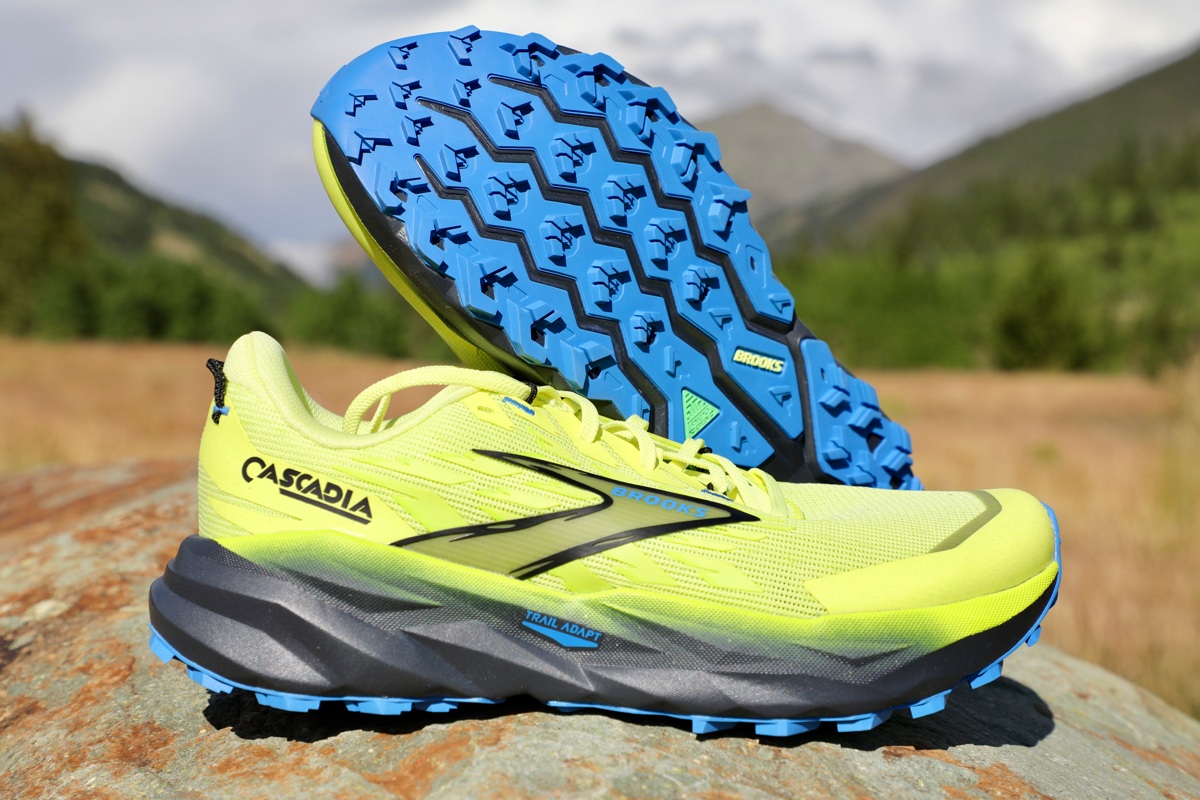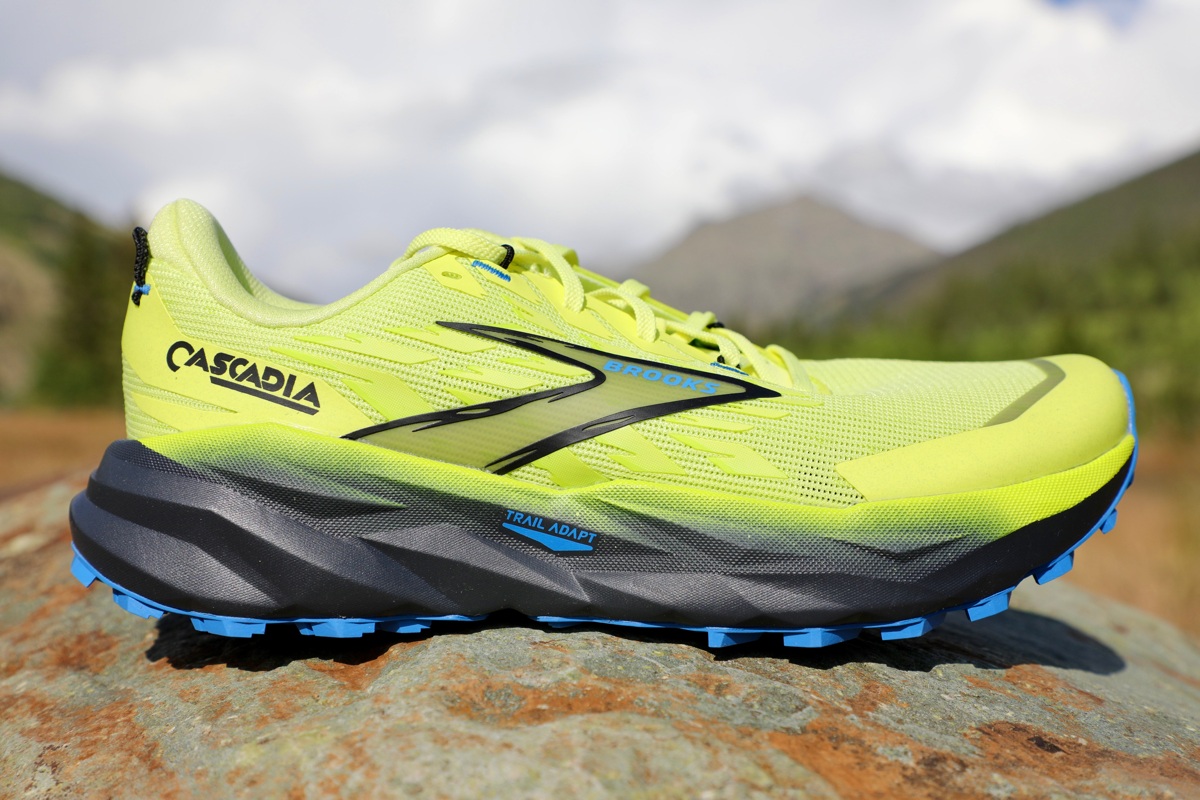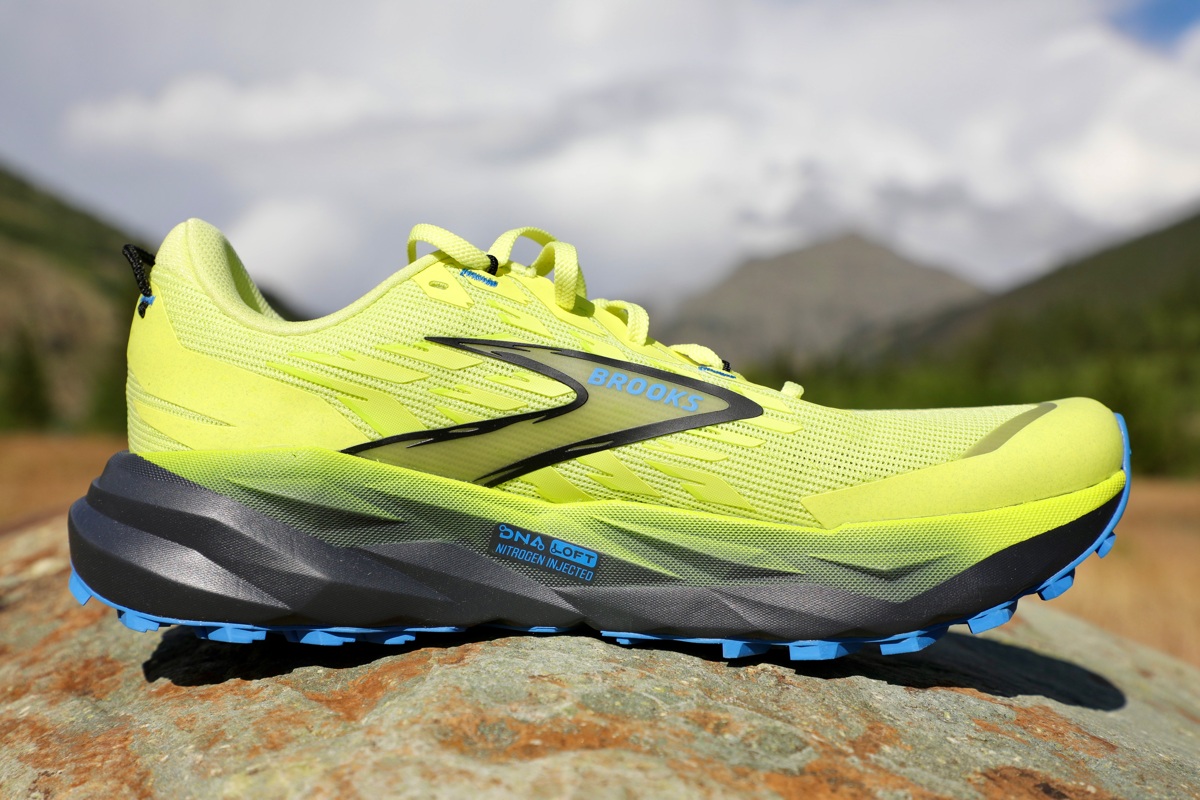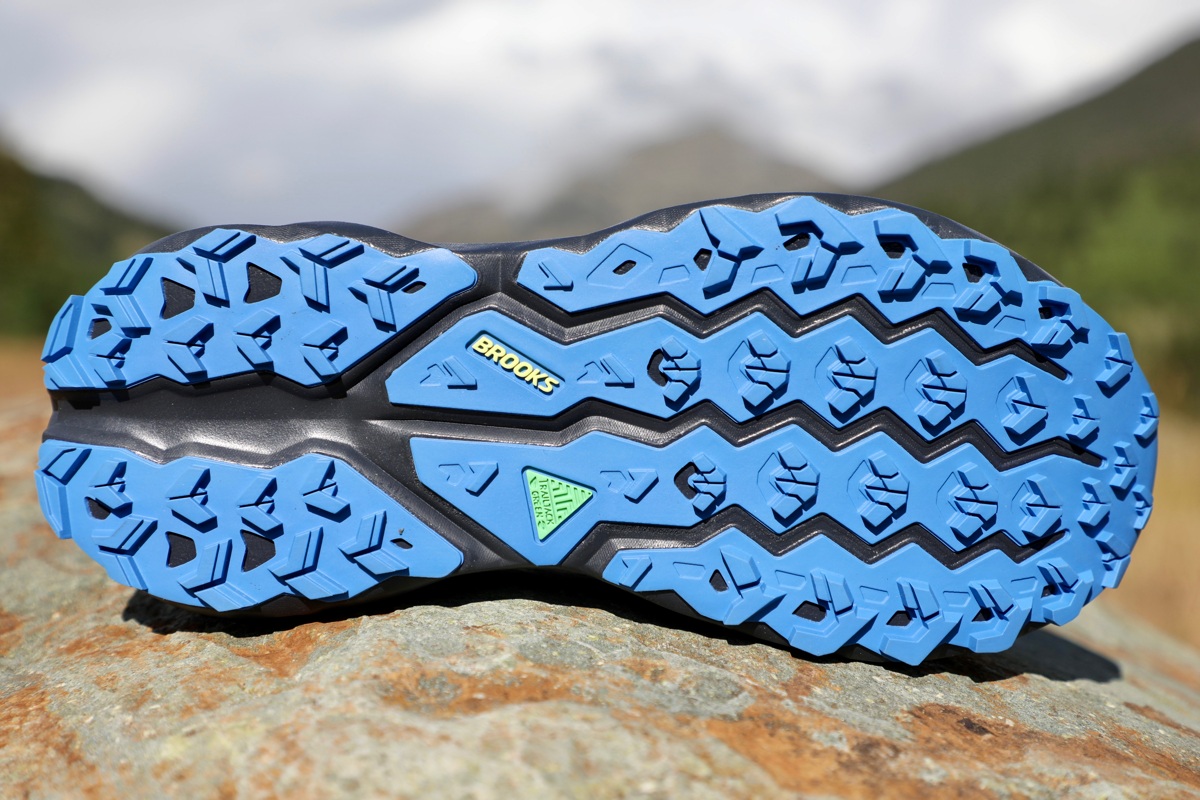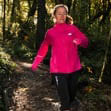The Brooks Cascadia 19 ($150) is, dare I say, my favorite Brooks Cascadia of all time. It has far surpassed its burlier but clunky early days and provides a lighter, quicker, more agile run while not leaving behind those of us who prefer more protection and cushioning in the middle and further back in the pack. I wore these out of the box on an 11-mile hilly, rocky, rubbly Colorado Front Range run and could have gone further in that smooth-rolling, balanced-yet-dynamic trail shoe if time and schedule had allowed.
The Cascadia 19 has lightened up a tad to an actual weight of 10.7 ounces (303 grams) for a U.S. men’s 9. While the weight change may seem subtle, it truly is the zippiest feeling Cascadia thus far — not quite road shoe zippy, but moving in that direction without losing the important trail traction and protection.
Interestingly, Brooks dropped the shoe down to a 6-millimeter drop, with claimed stack heights of 35 and 29 millimeters at the heel and toe, which normally raises some flags for me with my body’s distinct preference for 8+-millimeter, but my calves and hamstrings didn’t seem to notice the difference, even after 105 miles in them. I’m not certain why that is as I can usually give the Princess and the Pea a run for her money with drop, but maybe the notably upgraded Nitrogen-infused midsole and Trail Adapt technology help to smooth out the difference.
The Cascadia 19 comes in men’s and women’s sizing, wide versions, and a Gore-Tex model that we didn’t review here.
This version of the Cascadia is for the new trail runner who is committed to the cross over to trails and mountains alike, and desires a level of protection that allows for that, yet doesn’t want to sacrifice the quicker and more responsive feel they love about the roads. Equally, it’s for the long-time trail runner who sometimes finds all-mountain shoes to be a bit overbuilt and wants to be able to enjoy the agility, ease, and relative speed that experience can bring over a variety of terrain.
Sizing note: I wear the larger end of my size range for this shoe, just like I wear in La Sportiva, New Balance, and others, and a full size larger than Salomon. If you’re in between sizes, definitely try the smaller and larger size — I might just like 1/4 size smaller for security’s sake in more technical terrain.
Shop the Women's Brooks Cascadia 19Shop the Men's Brooks Cascadia 19
Brooks Cascadia 19 Upper
The upper of the Brooks Cascadia 19 provides a strong example of Brooks commitment to sustainability, thanks to the 53% recycled materials utilized. The markedly breathable mesh is fairly similar to version 18, but the overlays are a bit lighter and less continuous in the midfoot and heel, which allows for similar structural stability, but a bit less stiffness and better water drainage. I feel like this iteration drains better than all prior versions, even with a quick submersion. Your experience may vary.
The toe bumper is exceptional in coverage but is flexible enough to not create any pressure points, even if you’re a bit of a toe-gripper like I am on sketchy downhills.
The higher volume toebox also allows for plenty of splay and room even over the course of a long ultra, but if you have an average or slightly narrower foot, it may provide almost too much room for sustained off-angle slabs. It was harder to really lock in the mid-foot and fore-foot for such terrain, maybe in part due to the less continuous overlays, but since I don’t find myself on that type of surface for too long most of the time, it’s not a limiting factor. I could see this being potentially challenging in some of the more off-angle slabs in Moab perhaps, or on the supremely rocky trails in upstate New York.
Three cheers for Brooks for keeping the well-padded and fairly historically standard tongue shape and form, ankle collar, and Achilles notch. My ankle bones, anterior and lateral ankle tendons, and Achilles are so, so happy. The flat laces stay tied with one double knot, and I never have to futz with them once I get into my run. I do like the overlay design for the eyelet reinforcement as it’s unobtrusive to the foot and is holding up well with general wear and tear.
A lightweight, understated cord loop is at the back for the on/off of the shoe or transporting via carabiner outside your bag. All in all, I have no suggestions for the upper. It’s great. Nothing flashy, except the highlighter yellow color.
Brooks Cascadia 19 Midsole
Brooks really hit the mark with the updated midsole in the Brooks Cascadia 19. They’ve finally added the Nitrogen-infused version of the DNA Loft V3 here and the comfort, resilience, and smoothness of this midsole makes it comfortable to run long miles. It’s a lovely quick-stepping, well cushioned shoe, with no wasted energy through the gait cycle.
The Trail Adapt system has been improved such that the individual pods and the integrated protective yet adaptable forefoot rock plate respond to the uneven ground with more ease so that you can stay centered over your foot more easily without losing contact with the ground in my experience.
For those who are agile mountain goats, I imagine this makes faster running over technical terrain much easier and more enjoyable, as you retain good ground feel as the shoe molds and adapts over the surface. For those of us who are on the other end of the mountain goat bell curve, I feel less beat up and less proprioceptive fatigue in technical sections as I can stay centered over my foot easier as I try to hustle down the trail. At 105 miles, the midsole and ride feel just as fresh as that first run out of the box.
Brooks Cascadia 19 Outsole
The TrailTack Green outsole on the Brooks Cascadia 19 remains similar in make up with the 25% recycled materials and retains the excellent secure and sticky traction from version 18 in most circumstances. The durability is proving to be just as impressive, especially considering my runs have been particularly rocky and rubbly thus far.
The compound, itself, comes close to rivaling Vibram in my experience. The primary difference between version 18 and 19 of the Cascadia, though subtle, is decreased lug depth from 4.5- to 4-millimeters and an increase in the variety of chevron and other geometric-shaped lugs. The traction excels on wet or dry slab rocks, talus, roots, and smoother single track but doesn’t have enough bite for snow fields and the thin sandy ball bearings covering hardpack ascents and descents. Mud sheds quickly, however, since the low-profile lugs don’t create much depth for it to cling to. There’s always a trade-off with lug depth and running comfort, and given how comfortable it rolls on less aggressive or slabbier terrain, I’m very pleased overall.
I also appreciate the slight design change with three more continuous lengthwise breaks in the forefoot and midfoot outsole as it seems to add smooth stability to the ride by allowing for more medial/lateral contouring of the outsole to rough terrain, but not in a way that fatigues the foot and ankle. A large cutout in the heel is still shallow enough not to take on rocks or mud, but lightens the weight and allows for more adaptability to rocks, roots, and other off-camber terrain.
Despite the rougher terrain I’ve been running on, I’ve had no heel bruises so far, which is fabulous.
Brooks Cascadia 19 Overall Impressions
The Brooks Cascadia 19 is truly an all-mountain option where the protectiveness that allows for steep tundra climbs and descents doesn’t take away from the shoe’s ability to run fast on the smoother singletrack connecting the steeps. I love the agility and ease of the run in these, which maybe prior versions hadn’t quite nailed as well. This is no longer the clunky and heavy shoe of the first few iterations.
One of two limiting aspects from the all-mountain declaration for me is that my foot isn’t always entirely locked down on prolonged sharp angles — there can be a little sliding on the platform at times with the roomy forefoot in particular. I can dabble in various shoe tying strategies, but with my run locations of choice, this doesn’t affect me too often.
Secondly, the low-profile lugs aren’t quite toothy enough for good bite on the occasional snowfield or pebbly descent. Yet, they’re so easy to feel good in, I still wouldn’t hesitate to wear these for something like the San Juan Solstice 50 Mile in the San Juan Mountains, or pacing someone on any section of the High Lonesome 100 in the Sawatch Mountains, both of which are in Colorado.
They would do well around the mountains and rugged hills around Phoenix, the Mogollon Rim, and Flagstaff, Arizona. And they’d feel right at home on the doubletrack routes through the Sand Hills of western Nebraska, as well as the Pacific Crest Trail, or elsewhere in the Pacific Northwest until the mud season really sets in.
So, despite their lack of bite at times, in my opinion, this is the best Brooks Cascadia model yet for comfort and adaptability, ease of running, and all-day adventuring. With Brooks Running’s 90-day trial run guarantee, with no shipping or restocking fee, the Cascadia 19 is a no-brainer if you’re curious about it for your next trail shoe for running, hiking, and adventuring.
Shop the Women's Brooks Cascadia 19Shop the Men's Brooks Cascadia 19
Call for Comments
- Have you tried the Brooks Cascadia 19? What were your thoughts?
Our Favorite Trail Running Shoes
Learn more about our current favorite trail running shoes in our Best Trail Running Shoes guide.
